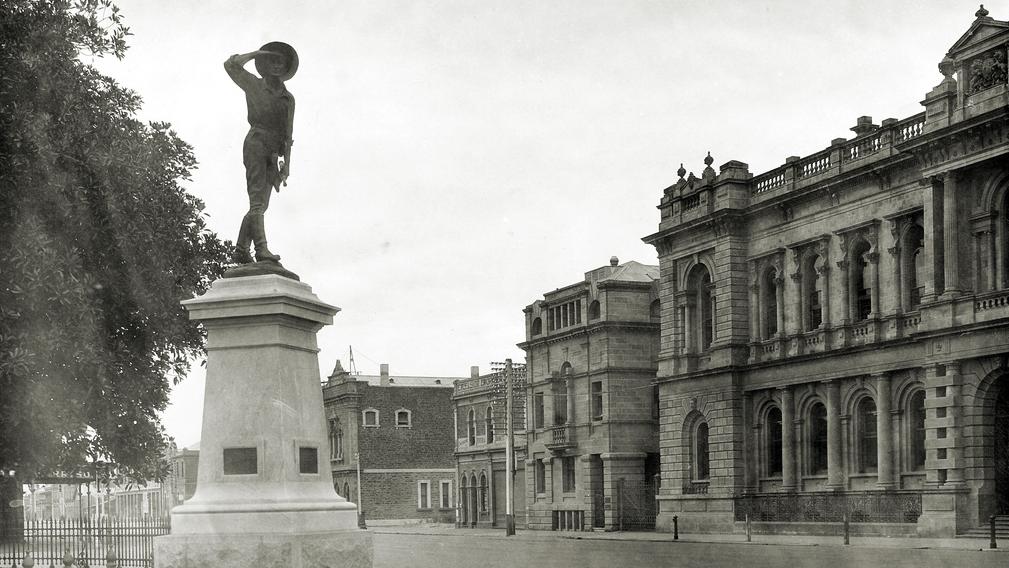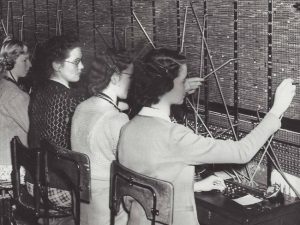IT has lain silent and deserted for years, and musty hallways and darkened rooms have gathered dust and cobwebs that covered the decaying infrastructure within. Still and soundless for so long, Adelaide’s original Central Telephone Exchange is about to bounce back to life and become part of a flashy new food and retail hub.
Last week, work started on the redevelopment of the GPO precinct, which is planned to have two multistorey office towers, retail outlets, eateries and shops built around the adjoining plaza and laneways, while the Telephone Exchange will be refurbished as boutique office space.
The GPO has always been considered one of the city’s finest buildings.

Franklin St in 1916, soon after the Sturt Statue was unveiled in December. Opposite is the Post Office building and in the centre is the Telephone Exchange. Picture: Francis Gabriel / State Library of SA B2158
It was opened with great celebration in 1872 and was later described as “the finest of public buildings” and “preferable to either the Melbourne or Sydney Post Offices”, by author Richard Twopeny in his publication Town Life in Australia.
The structure was finally completed in 1876, with the addition of the landmark Victoria Tower. The tower houses the clock, made to the specifications of Postmaster-General Charles Todd, and the bells, which were copied from those of Westminster Abbey and designed to chime on the quarter hour.
Inside the imposing construction was the grand postal hall, with its half-domed roof and cleverly designed layout of discreet offices arranged around the perimeter of the interior. These included special sections for money orders, stamps, mail delivery, private boxes and the telegraph receiving office.It was the most expensive building erected to that time by the colonial government in South Australia, at a cost in excess of £55,000 and to this day continues to play an important role in our city.
Next to that still-imposing edifice, in Franklin St, stands a much more modest structure, the Central Telephone Exchange. It was added in 1908 when the first telephone exchange, which was crammed into the back corner of the GPO, was no longer able to handle demand for the newfangled gadget, the telephone. SA had been quick to respond to Alexander Graham Bell’s 1876 invention, and by 1883 Adelaide had its very first telephone exchange, with 27 subscribers. That reportedly grew to almost 700 subscribers within three years.

Mary Branwhite, far right, works as a switchboard operator at the Adelaide GPO during WWII, in 1942.
It wasn’t until Federation in 1901, when the various state post and telegraph departments were joined into the Commonwealth Postmaster General’s Department (PMG), that the new device was able to expand at an exceedingly rapid rate.
Demand for the service easily outstripped supply and women usurped the first male operators, becoming crucial to the spread and maintenance of the telephone network. Thousands of women were hired and worked in the Central Telephone Exchange from when it first opened in 1908 until it finally closed in 1955.Legend has it that men, initially hired as switchboard operators, found the work tiring and were impatient and abrupt so women were brought in and found to be perfect for the job.
Many Baby Boomers may remember their first experience with a telephone as children or even teenagers. On picking up the phone, after a short delay, the operator would ask “Number please?” After giving the number, there was a short pause, then the operator would say “Go ahead” and you would be connected. Calls were charged by the minute and after a three-minute period, the operator might ask “Are you extending?” At the end of the call, you simply hung up and the call was disconnected.
In a recent post on our Adelaide Remember When Facebook page, a long-retired telephone technician took the trouble to explain how those early switchboards worked. “A wire goes out from your house to the main switch station (called ‘the exchange’),” he wrote. “One of the wires is a ‘ring’ line. You crank the phone and it generates about 50 volts, and rings a buzzer at the switch station. She asks you who you want to talk to, and then she rings their line and patches you into their line.” That is the very earliest phone system.
Also in those days, sometimes multiple houses would be on the same line to save on copper wires, and it was called a party line. Your phone would ring every time a call came in to anybody, and every time somebody called out. If you picked up the receiver, you could hear them, and were expected to hang up if it wasn’t your call. Often in those communities, the operators would devise a code, a long and a short, two shorts, a long and three shorts, that sort of thing.
The days of the switchboard operators at the Central Telephone Exchange are long gone but thankfully the old building gets another life as boutique office space in the new GPO precinct and so will continue to be part of our city’s proud history.

So, the Adelaide GPO was abandoned? That’s a bit sad, it was a grand old building. I’m glad they haven’t demolished it.
My second job, in 1969 after Haighs Chocolates, was at the GPO as a telegram delivery boy. We rode these big heavy red bikes all over the place (sometimes spending “unauthorised” time in a milkbar during our runs, but that’s another story), and wore thick and heavy uniforms and hats. We worked out of the basement of the main building. My sister worked in the telephone exchange next door.
Hard work sometimes, but good as well. The GPO even had a little tuck shop in the basement for the workers. It only sold junk food though.
There was a cafe just a few doors down King William Street towards North Terrace, maybe the Criterion? It was opposite the Town Hall I think. A bit like a “greasy spoon” (sorry about the Yank lingo), but the food was good.
I also worked as a telegram boy at the GPO building we used to ride our bikes under neath to the delivery section and wait our turn for the next telegram lwas seven days delivery service often i worked sunday nights and rode to as far as woodville often heavy rain and strong head winds this was 1955 i now live in perth aged 77 so those hard years of the 50s did me no harm as i never had Phone car internet etc my big moments was the Saturday movies 20cartoons and tarzan Hopalong Cassidy and Roy Rogers
I too worked in the basement of the GPO delivering telegrams by pushbike in the square mile of the city, got to know every street, lane and shortcut. After 6pm weekdays (until 10pm when night shift finished) and on weekends we would deliver within 3 miles of the GPO I started there on 25th of june 1973 after about 12 months I got transferred to BP house and then to the telephone exchange in Franklin street, great memories!
Does anyone remember Ilma Philips or a man with surname Causby in 1961.
Yes I do remember Iima Philips, I used to work with her at the Grosvenor Hotel I used to assist her on the switchboard when it got very busy. The Grosvenor was a fairly large switchboard, 12 outside lines, two private lines and over 508 extensions. They employed about four full time operators.
I also forgot to mention since your name is Bruce Smith, are you related to a Smithy or Ms. Smith one of the Grosvenor telephonists? others were Ilma Philips, Mrs. Buridge, and a pompous English lady a Mrs. Williams. Mrs. Williams used to work a broken shift 8am until 8pm four hour break in the afternoon. It used to be a very busy switchboard as all incoming and outgoing calls went through the operator. Must admit they certainly worked for their money and always polite!!!!
My mother, Dorothy Gum, worked as a telephonist at Adelaide Central Exchange during 1943-1944. She had recently arrived from the country and it was her first employment. She had many stories to tell of those days and loved her work.
My first job in 1961, as a JPO (junior postal officer), shifts started at 6 am – 10pm. I loved the smells
of the city, Hoadley’s around Halifax St. malt from West End Brewing in Hindley St the smell of the
Central Market. We were not allowed to ride our bikes down the ramp into the basement as it was to
too dangerous.